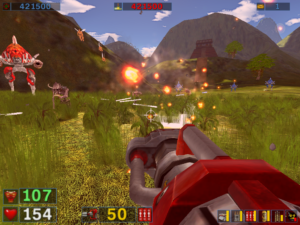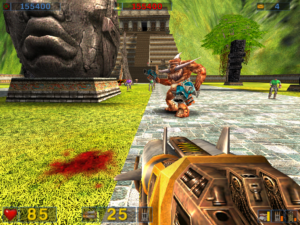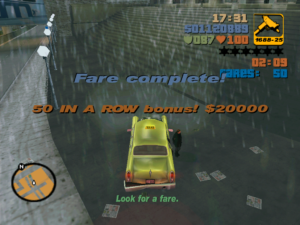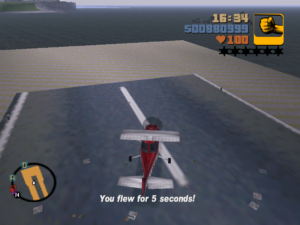SS2E: Small Enclosed Spaces
 Last time, I wrote about the Serious Sam‘s use of large spaces. This time I want to address its use of small ones. One of the tricks that this game repeats a lot is temporarily locking the player into an enclosed area, such as a courtyard, and spawning enemies along the walls, in sequence, on a timer. Only when you’ve killed them all do the doors open again. One of the level designers of Doom once described that game as “the computer equivalent of whack-a-mole”. I’d quibble about that as applied to Doom, but it’s a pretty good description of the feel of Serious Sam‘s locked-in-a-courtyard sequences. Things keep popping up, and you just have to try to keep pace with them, blasting them before they blast you.
Last time, I wrote about the Serious Sam‘s use of large spaces. This time I want to address its use of small ones. One of the tricks that this game repeats a lot is temporarily locking the player into an enclosed area, such as a courtyard, and spawning enemies along the walls, in sequence, on a timer. Only when you’ve killed them all do the doors open again. One of the level designers of Doom once described that game as “the computer equivalent of whack-a-mole”. I’d quibble about that as applied to Doom, but it’s a pretty good description of the feel of Serious Sam‘s locked-in-a-courtyard sequences. Things keep popping up, and you just have to try to keep pace with them, blasting them before they blast you.
The level I’m currently on (level 3, “The City of the Gods”) seems to specialize in sequences where you’re confined with large monsters in too small a space for comfort, and even has some new twists on the basic concept. There’s one part with an insignificant health item (one that restores 1 hit point) in a wedge-shaped area between buildings. The health item is bait; picking it up causes three missile-launching Bio-Mechanoids to appear on the tops of the walls, one after the other, in different directions. The area is so small that avoiding splash damage from their weapons is impossible. As far as I can tell, the only way to survive is to (a) sidestep a lot to make them take longer to aim at you (Bio-Mechanoids turn slowly), and (b) when they do fire, avoid getting hit directly by running under the missiles. This works only because they’re firing from above you. Or, of course, you can just refrain from picking up that trivial health item in the first place. Picking it up for the hit point is really counterproductive. But it counts as a Secret, and what kind of completist would I be if I didn’t try to get all the Secrets?
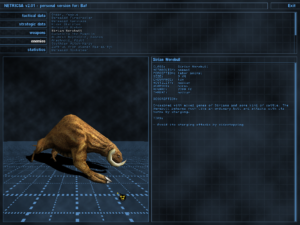 There’s another part where picking up a bonus item at the end of a winding corridor causes a Sirian Were-Bull to immediately appear more or less on top of you. This is one of those charging monsters, a very large one that barely fits in the corridor. The usual tactics are useless here: you cannot dodge something that fills all available space. You just have to blast it twice pointblank with a double-barreled shotgun while it’s still trying to turn towards you. And when I say you have to, I mean there’s really no other weapon that works in that situation: the only other weapons capable of doing enough damage quickly enough also do splash damage, which would hurt you more than the Were-Bull would.
There’s another part where picking up a bonus item at the end of a winding corridor causes a Sirian Were-Bull to immediately appear more or less on top of you. This is one of those charging monsters, a very large one that barely fits in the corridor. The usual tactics are useless here: you cannot dodge something that fills all available space. You just have to blast it twice pointblank with a double-barreled shotgun while it’s still trying to turn towards you. And when I say you have to, I mean there’s really no other weapon that works in that situation: the only other weapons capable of doing enough damage quickly enough also do splash damage, which would hurt you more than the Were-Bull would.
Come to think of it, these sequences are essentially puzzles. Perhaps this game isn’t quite as mindless as I give it credit for. Then again, they’re also both optional.
 Comments(0)
Comments(0)